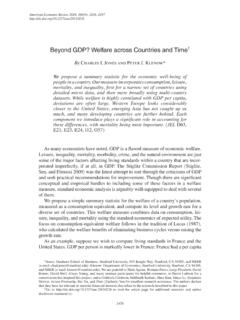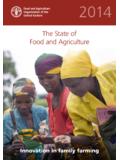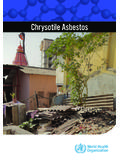Transcription of The impact of disasters on agriculture - Home | Food and ...
1 The impact of disasters on agricultureAddressing the information gapCover photo: FAO/F. NyakairuThe impact of disasters on agricultureAddressing the information gapFood and agriculture Organization of the United NationsRome, 201723 FAO/F. Grunewaldin developing countries the agriculture sector absorbs 23 percent of the total damage and losses5 The impact of disasters on agriculture is severe, yet under-reported. FAO is bridging the knowledge gap by quantifying crop and livestock production losses from disasters in developing countries FAO/A. Hafeez6between 2005 and 2014, approximately USD 93 billion was lost in crop and livestock production due to natural hazards and disasters in developing countries7 Drought continues to challenge agricultural systems across Africa countries may lose up to 20 percent of potential agricultural production due to severe drought episodes FAO/F.
2 Nyakairu 8 More disasters , but dearth of information on damage and losses in agricultureCaribbean and Central AmericaNorth Africa and Western AsiaSouth AmericaSouth AsiaLinear TrendFigure 1. Occurrence of natural disasters (number per annum), 1980 2016 East AfricaSoutheast AsiaWest and Central AfricaOceania (Pacific SIDS)Southern AfricaFAO, based on the Emergency Events Database of the Centre for Research on the Epidemiology of disasters (EM-DAT CRED) 3503002502001501005002014201520162013201 2201120102009200820072006200520042003200 2200120001999199819971996199519941993199 2199119901989198819871986198519841983198 2198119809 The number and frequency of recorded natural disasters , along with the associated impact and damage to livelihoods and economies (local and national), are increasing significantly.
3 Natural disasters often destroy critical agricultural assets and infrastructure, disrupting production cycles, trade flows and livelihoods means. This affects food security and causes additional disruptions throughout the value chains. Such disasters may slow overall economic growth, especially where agriculture and food production still account for a large share of gross domestic product and employment. Notwithstanding the many efforts at national and international level, there is limited systematic data and information on the impact of disasters and hazardous events in agriculture and its subsectors crop, livestock, fisheries, aquaculture and forestry. Caribbean and Central AmericaNorth Africa and Western AsiaSouth AmericaSouth AsiaLinear TrendFigure 1.
4 Occurrence of natural disasters (number per annum), 1980 2016 East AfricaSoutheast AsiaWest and Central AfricaOceania (Pacific SIDS)Southern AfricaFAO, based on the Emergency Events Database of the Centre for Research on the Epidemiology of disasters (EM-DAT CRED) 3503002502001501005002014201520162013201 2201120102009200820072006200520042003200 2200120001999199819971996199519941993199 2199119901989198819871986198519841983198 21981198010 The 2030 Agenda for Sustainable Development stipulates that all countries , irrespective of their income level, are prepared to effectively prevent and mitigate any disaster impacts. Where disasters cannot be avoided, countries should act to minimize the devastating effects on livelihoods and the economy. agriculture must be at the centre of these efforts, given its wide interactions with the environment and direct reliance on natural resources for production.
5 disaster risk reduction (DRR) strategies are essential, so that increasingly frequent hazardous events1 do not push countries and communities into poverty loops. Political and financial backing for DRR must be mobilized through adequate policy frameworks. This calls for the establishment of a robust evidence base. A thorough analysis of existing trends in agricultural production and related distortions in production volumes and patterns due to disasters is a key starting point2. Such analysis can bridge the information gap and inform decision-making for DRR, sustainable development and emergency response 2015, the Food and agriculture Organization of the United Nations (FAO) launched the first report entitled The impact of disasters on agriculture and food safety.
6 It showed that a staggering 22 percent of total damage and losses from natural hazards in developing countries were absorbed by the agriculture sector alone. The report also highlighted the need for deeper analysis, more thorough data and the construction of a coherent information system. A better understanding of the sector-specific magnitude and nature of disaster impact is crucial for informing adequate risk reduction policy and practice, as well as for guiding investment in climate-resilient agricultural part of an ongoing effort to fill the knowledge gap and foster a better understanding of how the agriculture sector is affected by disasters , FAO is releasing the second periodic report in 2017. 1 According to the UNISDR terminology, a disaster is a serious disruption of the functioning of a community or a society at any scale due to hazardous events interacting with conditions of exposure, vulnerability and capacity, leading to one or more of the following: human, material, economic and environmental losses and impacts.
7 2 Agricultural production in the FAO context refers to: crop, livestock, aquaculture and forestry production as well as fisheries second report includes analyses of impacts from natural hazard-induced disasters3, namely: drought and other meteorological and climatological disasters (extreme temperatures, storms and wildfires) floods geophysical (earthquakes, tsunamis and mass movements) biological disasters (epidemics, infestations and animal disease)The report also includes a special focus on biological disasters , such as transboundary animal diseases as well as on protracted crises in conflict contexts. FAO has applied a combination of methods, juxtaposing different information sources to gauge estimates of damage and losses incurred in crops, livestock, fisheries, aquaculture and forestry in the aftermath of hazardous events and addition to large-scale events, medium- and small-scale disasters , despite their limited scale, can have a significant impact .
8 The second report considers different types of disasters affecting over 100 000 people or more than 10 percent of the national population. 3 The classification of disasters adopted here draws on the EM-DAT CRED and climate-related damage Geophysical damage Figure 2. Economic damages of disasters triggered by natural hazards worldwide, 1980 2014 Source: EM-DAT CRED250200150100500198019821984198619881 9901992199419961998200020022004200620082 010201220142016 USD billion12 Production losses: crops and livestock This brochure4 focuses on crop and livestock losses triggered by natural hazards and the spread of animal and crop pests and diseases in developing countries in sub-Saharan Africa, Asia, Latin America and the Caribbean, North Africa and western Asia5.
9 Special emphasis is given to small island developing States (SIDS). 4 Within this broad (macro-level) analysis of agricultural impact from disasters , only production losses in the crop and livestock sectors are considered; this is mainly due to data availability and compatibility with the type of analysis employed. The upcoming report, however, contains both sector-specific analysis and targeted case studies on each subsector, namely fisheries, aquaculture and forestry, as well as crops and livestock, and therefore provides a thorough overview of how each subsector is impacted by disasters and natural Including Armenia, Georgia, Lebanon, Syria and 2005 and 2014approximatelyUSD 93 billion was lostas a result of declines in crop and livestock production after natural hazards and disasters in developing countriescaused 37% caused 19% representing 23%of overall production losses Floodsdroughtother climatological disasterslossesof the cumulative production losses in crops and livestock.
10 Amounting to just under USD 34 billionof agricultural losses, which amounted to over USD 17 billionsuch as extreme temperatures, storms and wildfires, set the sector back over USD billionEarthquakes/landslides/mass movementsEarthquakes/landslides/mass movementsDroughtDroughtExtreme temperatures/storms/wildfiresExtreme temperatures/storms/wildfiresFloodsFlood sFigure 3. Crop and livestock production losses per disaster type, 2005 2014 Crop pests/animal diseases/infestationsCrop pests/animal diseases/infestations12%19%23%37%37%9%me Extreme temperatures/storms/wildfires80%14A focus on droughtDrought continues to challenge agricultural systems across Africa. The extreme vulnerability to rainfall variability in the arid and semi-arid areas of the continent and the poor capacity of many soils to retain moisture result in an often devastating impact on the sector.

















